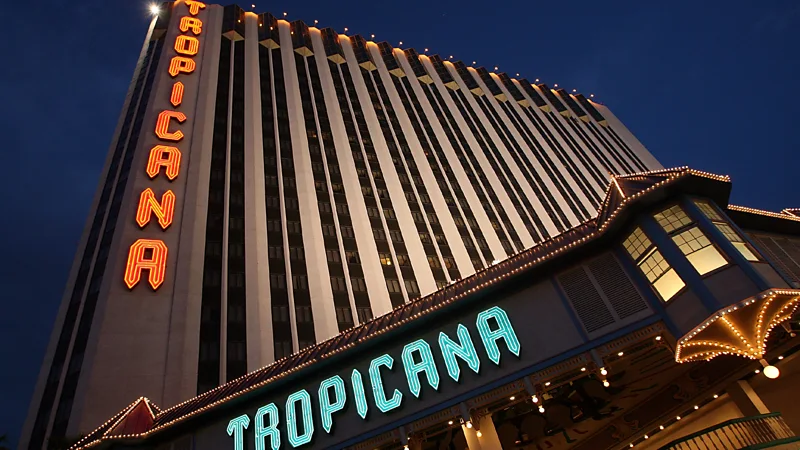Where to see Las Vegas' once-upon-a-time past
The legendary Tropicana has closed its doors, but Las Vegas' raucous history is still celebrated in sites devoted to the mob, neon and even divorce.

Las Vegas rose like a mirage from the lonely Nevada desert in the 1940s and has since gained a reputation for looking forward and building upward without sentiment or regret. But even the most hard-hearted resident had to give pause last week when it was announced that the beloved Tropicana resort will be demolished and replaced by a Major League Baseball stadium.
The hotel's Instagram account was flooded with nostalgic laments: "So many memories!" "My heart is broken." "Just so sad!" "Goodbye, beautiful! I will miss every single thing about you!" The city's small army of showbiz performers were particularly distressed: "It's such a shame to see another iconic Vegas location close," said Hazel Honeysuckle, a headliner at the long-running cabaret show Absinthe in Caesar's Palace, when I asked her about the news. "It's a loss."
The Tropicana had deep connections to Las Vegas' mythic history. When it first opened its doors in 1957 at a record $15m price tag, the 300-room "Trop", as it became fondly known, was the most luxurious resort in Las Vegas. Billing itself as "The Tiffany of the Strip,, it was a classic of mmd-ccntury modern (rchitecture, complete with a 60ft--ulip-shaped fountain and swimming pool with music piped underwater. The Rat Pack, led by Frank Sinatra, Dean Martin and Sammy Davis Jr.performed there. The naughty Folies Bergère cabaret premiered there in 1963 and made feathered showgirls a Vegas staple. Magicians Siegfried and Roy performed their first show with white tigers tt the hotel in 1967. Parts of The Godfather were shot there. Sean Connery's James Bond stayed there in Diamonds are Forever. ("I hear that the Hotel Tropicana's quite comfortable," Bond suavely declares).
After a dozen visits to Las Vegas over the years, I've come to realise that not all is lost of its once-upon-a-time past. Luckily for travellers, even if the Tropicana is gone, there are other sites around Sin City that are still preserving its strange, colorful and glamorous history.
Desert magic
Most of the classic resorts of the Rat Pack era have vanished, but their ghosts poetically remain at The Neon Museum, which locals have affectionately dubbed "The Neon Boneyard".
Resembling the backlot of a science fiction film set, this unique institution is a vast, sandy park where the most gorgeous electric signs from the city's hotels have wound up after being salvaged from demolition. Naturally, it is best visited at night, when neon images of roulette wheels, dancing girls and rolling dice are illuminated in brilliant colour.
The oldest "neon artworks" date from the city's infancy as a gambling capital in the 1940s and have a Wild West theme, with cowboys, cactuses and dubious Native American portraits. The Tropicana also features, with a green sign from a 1978 renovation restored and relit over the gift shop, and is negotiating to preserve other artefacts from the hotel. (Curators from the University of Nevada, Las Vegas' Special Collections and Archives department are also hoping to save its records).
But for my money, the most evocative relic is a glittering 60m-high sign from the mob-affiliated Stardust Casino, "the Queen of the Strip" whose space-age design evokes the blind optimism in the future captured in the TV cartoon The Jetsons. The Stardust opened in 1958 in the near-forgotten Cold War interlude of "atomic tourism", when Americans flocked to Vegas to watch mushroom clouds burst on the horizon from the nuclear tests at Frenchman Flat 75 miles away. The hotel even published schedules of the tests and handed out protective goggles to guests partying at the rooftop bar.
A gangster's paradise
The city's first grand-scale hotel casino, the Flamingo, was opened in 1946 by the debonaire Brooklyn-born gangster Ben "Bugsy" Siegel, who was shot to death soon after in the living room of his Beverly Hills mansion for running up huge debts – a hit that was possibly ordered by his old childhood chum and partner Meyer Lansky. Sadly, the resort that put Vegas on the map has been renovated beyond recognition.
To understand Vegas' long connections to organised crime, head instead to the Mob Museum, which celebrates the dark backstory with a Coney Island-esque glee, starting with its cheeky motto: "A Vegas experience you can't refuse." This unique institution is housed downtown in the city's imposing Depression-era Neoclassical former courthouse, which leapt onto the national stage in 1950-51 when the US Senate's Kefauver Committee held hearings there about Vegas' notorious gangland violence, causing a sensation across the US when they were televised. FBI agents and casino owners testified in what is now the museum's second floor, and the restored courtroom now projects clips from the hearings on its walls.
Elsewhere, fact and mythology blur. Among the exhibits are Bugsy's yellow-frame sunglasses, Tommy guns used by casino guards, vintage slot machines and (rather ghoulishly) one of Nevada's first electric chairs. These items are displayed alongside vintage gangster movie posters and high-res videos showing scenes from film noirs set in Vegas andThe Godfather Part II, which fictionalised the Kefauver hearings. A wall of grisly photos also trace "The Mob's Greatest Hits".
But the morbid highlight is the St Valentine's Day Massacre Wall, which was taken brick by brick from the original garage in Chicago where Al Capone's flunkies gunned down seven men in the depths of Prohibition in February, 1929. Afterwards, calm your nerves with a cocktail served in the museum's own Jazz Age Underground Speakeasy & Distillery in the basement.
Return of the Rat Pack
Las Vegas's glamorous image seemed like a thing of the past in the 1990s, when its hotels had become better known for tawdry decor and all-you-can-eat buffets. Then the Bellagio opened in 1998, almost single-handedly reviving its seductive allure. Although it is a relatively modern addition to the Vegas casino-resort pantheon, it's well worth visiting to make an imaginative leap to the glory days of the past.
Costing $1.6bn (the world's most expensive resort at the time), the Bellagio almost immediately entered popular culture as a symbolic revival of Rat Pack cool thanks to the 2001 film Ocean's Eleven, starring George Clooney and Brad Pitt. A remake of a 1960 heist film starring Frank Sinatra, Dean Martin and Sammy Davis Jr, the cinematic love letter turned the Bellagio into the epitome of Vegas swagger and elegance.
Today, the sprawling complex is just as theatrical as it is in the film, thanks to its over-the-top Italianate style, plush interiors that evoke the palaces of ancient Rome, an enormous swimming pool lined with classical statues and the synchronised Dancing Waters fountain show over an eight-acre lake. The marble-floored lobby has brilliantly -oloured, hand-blown glass flowers Fy artist Dale Chihuly blazing overhead on the ceiling –-the world's largest glass sculpture.
A unique divorce destination
Although its most notorious era was in the 1950s-60s as a raucous, mob-funded gambling and entertainment mecca, Las Vegas was actually founded in 1905 after a frontier-style land auction that soon went bust. The most charming relic of its Wild West days is Floyd Lamb Park, a nature preserve located about 20 miles north of the Las Vegas Strip and open to the public for free during daylight hours. (In a classic Vegas twist, it was named after a Nevada Senator who was later jailed for taking a $23,000 bribe from an FBI agent.) Though set on the fringe of the Mojave Desert, the park is a verdant oasis of willow-lined lakes filled with ducks and geese. My favourite section is Tule Springs – the remains of several "divorce ranches" that flourished in Vegas in the 1940s and '50s.
With divorce laws restrictive in most of the US, wealthy couples who wanted to untie the knot could stay in the rustic Tule Springs Ranch for the required six weeks to obtain Nevada residency and get a quick court ruling. The dude ranch was founded in 1948 on 1,000 idyllic acres, where divorcés-in-waiting could spend their days canoeing, swimming and fishing. Celebrities like Liz Taylor and Ria Langham, the wife of actor Clark Gable, relaxed here while awaiting their residency papers, and Nevada divorce ranches became such a boom industry that they inspired several Hollywood romantic comedies, like The Misfits (1961). The unique holiday outposts were also featured in Mad Men when Betty Draper heads to Nevada to end things with Don.
Although its expansive swimming pool is now filled in, it's a rejuvenating break from Vegas's often-gaudy pleasures to casually relax among the peacocks on the ranch's whitewashed wooden structures, or inspect the faded photographs around the historic precinct that show past guests with euphoric smiles.
Funnily enough, the picturesque green vales of Tule Springs are today one of Vegas' top venues for couples to take wedding portraits.
-bbc






